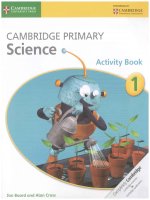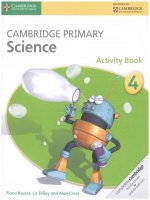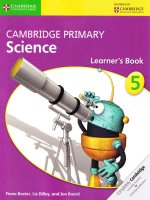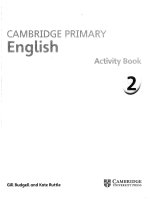cambridge primary science 2 2ed learners book
Bạn đang xem bản rút gọn của tài liệu. Xem và tải ngay bản đầy đủ của tài liệu tại đây (2.65 MB, 20 trang )
CAMBRIDGE
UNIVERSITY PRESS
CAMBRIDGE
Primary Science
Learner’s Book 2
Jon Board & Alan Cross
ens
Second edition
Cambridge Assessment
International Education
Endorsed for full syllabus coverage
CAMBRIDGE
UNIVERSITY PRESS
CAMBRIDGE
Primary Science
CAMBRIDGE
UNIVERSITY PRESS
University Printing House, Cambridge CB2 8BS, United Kingdom
One Liberty Plaza, 20th Floor, New York, NY 10006, USA
477 Williamstown Road, Port Melbourne, VIC 3207, Australia
314-321, 3rd Floor, Plot 3, Splendor Forum, Jasola District Centre, New Delhi - 110025, India
103 Penang Road, #05-06/07, Visioncrest Commercial, Singapore 238467
Cambridge University Press is part of the University of Cambridge.
It furthers the University's mission by disseminating knowledge in the pursuit of
education, learning and research at the highest international levels of excellence.
www.cambridge.org
Information on this title: www.cambridge.org/9781108742740
© Cambridge University Press 2021
This publication is in copyright. Subject to statutory exception
and to the provisions of relevant collective licensing agreements,
no reproduction of any part may take place without the written
permission of Cambridge University Press.
First published 2014
Second edition 2021
20
19
18
17
16
15
14
13
12
11
10987654
Printed in Malaysia by Vivar Printing
A catalogue record for this publication is available from the British Library
ISBN 978-1-108-74274-0 Paperback with Digital Access {1 Year)
ISBN 978-1-108-97255-0 Digital Learner's Book (1 Year}
ISBN 978-1-108-97256-7 eBook
Cambridge University Press has no responsibility for the persistence or accuracy
of URLs for external or third-party internet websites referred to in this pubtication,
and does not guarantee that any content on such websites is, or will remain,
accurate or appropriate. Information regarding prices, travel timetables, and other
factual information given in this work is correct at the time of first printing but
Cambridge University Press does not guarantee the accuracy of such information
thereafter.
Cambridge International copyright material in this publication is reproduced
under licence and remains the intellectual property of Cambridge Assessment
International Education.
Third-party websites and resources referred to in this publication have not been
endorsed by Cambridge Assessment
NOTICE TO TEACHERS !N THE UK
It is illegal to reproduce any part of this work in material form (including photocopying
and electronic storage) except under the following circumstances:
(i), where you are abiding by a licence granted to your school or institution by the
Copyright Licensing Agency;
(i), where no such licence exists, or where you wish to exceed the terms of a
licence, and you have gained the written permission of Cambridge University
Press;
.
(ii) where you are allowed to reproduce without permission under the provisions
of Chapter 3 of the Copyright, Designs and Patents Act 1988, which covers, for
example, the reproduction of short passages within certain types of educational
anthology and reproduction for the purposes of setting examination questions.
Introduction
Introduction
Welcome to Stage 2 of Cambridge Primary Science.
Stage 2 has many exciting science topics and we hope you will enjoy
the fun activities.
You are going to learn about:
The environment around you
How forces make things change
How and why we use materials
How humans and animals grow
Light sources, darkness and the Sun
‘ Electricity and making circuits.
We know you can do science yourself, so each unit has lots of practical
activities and investigations for you to try. We will ask you to talk about
what you know already, about what you think will happen in the activities
and about what you find out. You will need to ask questions and talk about
ways to find the answers. You will need to look at things carefully and
sometimes take measurements. You will learn how to draw block graphs
and how to make models to learn more in science.
Each unit has a project where you can find out
how science is used in the world around you
and how the ideas of scientists have changed
over time.
We hope you enjoy thinking and working
like a scientist!
Jon Board and Alan Cross
Contents
Contents
ví
|How to use this book
2
2
|1 Environments and
habitats
|11 Habitats
7
| 1.2 Plants in different
habitats
.
TTL}
Biology:
Structure and
function) h
Biology: Lite
processes
13 | 1.3 Animals in different
Scientific enquiry: | Explain how we can use
purpose and
science to help us understand
planning
/
oe 7 affect the world we
Seeneie Soquirys
carrying out
scientific enquiry
Scientifi
habitats
l
Mã
Saree
analysis,
19 | 1.4 Rocks and the
environment
evaluation and
conclusions
27 | 1.5 How can we care for
our environment?
36
36
4
|2Forcesand movement | Physics: Forces | Scientific enquiry: | Understand that we all use
|2:1Egiteedioiidus
and energy
purpose and
science and find out who
2'5'CRGdöR
h
7
.
enging Snape
47 | 2.3 Changing speed
planning
Scientific enquiry:
carrying out
52 | 2.4 Changing direction
uses science in their jobs.
scientific enquiry
Scientific enquiry:
analysis,
evaluation and
conclusions
59 | 3 Getting materials right | Chemistry:
Materials and
5?
Tin
Ba
their structure
E4
64 | 3.2 Properties of materials chemistry:
70
|33 Me
:
ạ
the right
Properties of
materials
Scientific enquiry: |
purpose and
| planning
ienti
iry: |
Sclentnc SNGUy?
corrying out
scientific enquiry
materia!
.
73 | 3.4 Testing materials
Chemistry:
Changes to
Scientific enquiry:
analysis,
78 | 3.5 Changing materials
materials
evaluation and
conclusions
Explain how we can use
science to help us understand
how we affect the world we
live in.
Contents
88 | 4 Humans and animals
grow
88 | 4.1 Comparing animals
94
43 Growin
.
| ng
Inheriting
101 | 4.3
cheardictaristics
Biology:
Structure and
function
Biology: Life
processes
Scientific enquiry: | Understand that we all use
purpose and
planning
Scientific enquiry:
science and find out who
uses science in their jobs.
carrying out
s
ae
5
scientific enquiry
106 | 4.4 Keeping healthy
112 | 4.5 Teeth
123 | 5 Light
123)
|§:1'Light sources
Pinel
Physics: Light
and sound
130 | 5.2 Darkness
| Scientific enquiry: | Talk about how
purpose and
planning
people's knowledge and
understanding of science
Scientific enquiry: | Were different in the past.
137 | 5.3 The Sun appears to
move!
carrying out
scientific enquiry
Scientific enquiry:
analysis,
evaluation and
conclusions
146 | 6
146
Electricity
|6.1 Where do we use
electricity?
152 | 6.2 Keep safe with
electricity
159 | 6.3 Making circuits
Physics:
Electricityand
magnetism
Scientific enquiry: | Explain how an object works
| purpose and
planning
Scientific enquiry:
eae
out
sa
si
3 + x
Scientific enquiry:
evaluation and
conclusions
175 | Glossary and index
185 | Acknowledgements
š
scientific enquir
analysis,
170 | Science skills
using science.
How to use this book
>
How to use this book *
In this book you will find lots of different features to help your learning.
Meee uy ccd
What you will learn in
the topic ——————————»
Questions to find out what
you
know
already.
Important words
to learn.
* Tella friend why every living thing needs the right habitat.
=—=....
+
Draw a
local habitat where plants live.
litter
material
eee
eee
protect
recycle
Find me a habitat
Pretend you are one of the three
plants in this activity.
A fun activity about the Science | read the information.
you
are
lea rning.
›
Then make a poster to say ‘Can you
find me a habitat like this?’
Rice needs a habitat which is warm,
with lots of light and water.
grows in very wet soil.
Rice
Plants in different habitats
Go outside and look at different places around your school.
Look for plants growing in
different habitats:
+ against a wall
An investigation to carry out
+ ina shady place
with a partner or in groups. —>
|+° "ores
ina dry pathway
+ under something
+
inaplant pot.
This plant is growing on a path.
Its roots have grown down a crack to
find soil.
"
Take a photograph or draw a picture of a plant and where it is growing.
You can record your plants and habitats like this.
»
How to use this book
Questions to help you think
about how you learn. ————>
This is what you have
learned in the topic. —————>
Questions that cover what
you have learned in the unit.
If you can answer these, you
are ready to move on to the
next, unit, —$—$——
At the end of each unit, there
is a project for you to carry
out, using what you have
learned. You might make
——>
something or solve a problem.
Project: Our school's outdoor environment
Make a small book about the environment of the
school grounds.
Think about:
* habitats for plants
* habitats for animals
+ _ where you could put an insect hotel
ways to improve the outdoor school environment
for plants and animals
*
2?
where you could put a nature reserve.
Use photographs, pictures and words to tell readers about the
school grounds and the animals and plants that live there now.
Make sure you show some good habitats for animals and plants.
Think of ways to improve habitats or make new ones.
How would you care for and improve the outdoor spaces
around the school?
vii
tank
DEAE
era Diy “| 39LTV JẾT., cer
aS
e
explore the environment to find the habitat of a living thing
e
talk about different living things in a habitat
e
compare two local habitats
e
make a model of a habitat
e
make observations and record them in drawings.
Each animal needs an environment which is a good habitat for them. e
The environment is the air, water and land where people, animals
and plants live.
e
Talk about the animals shown on this page and the environment they
need to live in. Draw the environment needed by these animals.
compare
environment
habitat
home
Each living thing needs a place to live.
We call this place the living thing’s habitat.
A habitat gives the living thing everything it
needs to live.
The plant's habitat is a wall. The wall is its
The plant has everything it needs to live.
It needs, light, water, soil and air.
It has a very small habitat.
The eagle's habitat is around forests
and lakes. Here, the eagle finds
everything it needs to live.
It needs food, water, air and a home.
It has a very large habitat.
Look at the other animals and plants in the picture.
What is their habitat?
Can they find all they need?
1
Environments and habitats
Your local environment
"g
has different habitats for
different animals and plants.
:
ì
A
?
What living things and their
habitats are in this picture?
Plants grow in a habitat but
they cannot move from place
be part of
a garden.
to place.
Animals can move in
their habitat.
A lizard's
habitat can
be a rocky
place.
Activity
Habitat for a frog
A habitat for a frog might be a wet
area, stream or pond.
Imagine you are a frog. What would
you want to find in your habitat?
Now draw the habitat for a frog.
Label your drawing to say what
each thing is.
Would this habitat be a home for
other animals and for plants?
Draw these other living things in
your picture.
:
ZA spider's
lon So
Think like a scientist 1
A habitat for fish
You will need:
a cardboard box, card, paper, scissors, coloured pens, glue
This tank is a habitat for fish.
Why do we call this tank a habitat?
Use a box to make a
habitat for fish.
ofa
You must give the fish everything
they need.
‘What will you include?
Think like a scientist 2
Looking at habitats
Look at these two habitats.
them. How are they different?
Why are there more plants and animals in one habitat than in the other?
Go outside to observe your local environment.
1
Environments
and
habitats
Continued
Talk about what the habitat is like in one place.
What plants grow? What animals might live here?
Now go to a different habitat in your local environment.
What plants grow? What animals might live here?
Draw the two habitats and show that they are different.
Add labels to your drawings.
Talk to your friends about why these habitats are different.
How am | doing?
Think of a local environment where we find habitats for different
animals and plants.
Share your ideas with a friend.
When
I learn about the world, does it help me
to compare different things?
| can explore the environment to find the habitat of a living thing.
|
| can talk about different living things in a habitat.
| can compare two local habitats.
LIT]
|
Lj
Look what I can do!
| can make a model of a habitat.
| can make observations and record them in drawings.
1.2 Plants in different habitats
| Weare
` PP
`
e
describe the place a plant lives as its habitat
e
describe different plants in a habitat
e
compare different habitats for plants
e
observe plants and record what we see in drawings and tables.
Getting started
e
Tell a friend why every living thing needs the right habitat.
‘e
Draw a local habitat where plants live.
Plants grow in many different habitats.
All plants need water. Many plants grow in or by water.
Plants grow by a river.
Plants grow in a
stream.
crack
photograph
describe
pretend
Environments and habitats
SS
Some plants live in hot
It is very dry here.
How can these plants live with
very little water?
Think like a scientist 1
Plants in different habitats
Go outside and look at different places around your school.
Look for plants growing in
different habitats:
s
against a wall
¢
inashady place
¢
ina wet place
¢
inadry pathway
*
under something
¢
ina plant pot.
This plant is growing on a path.
Its roots have grown down a
find soil.
Take a
You can
to
or draw a picture of a plant and where it is growing.
your plants and habitats like this.
Continued
| found this plant growing in the...
Here is a drawing of my
plant.
It has some soil?
yes/no
It has water?
yes/no
It has light?
yes/no
This habitat was...
/
7
How am | doing?
|
Look at the records made by your friends.
1
Environments and habitats
»
Environments where plants don’t grow
Different plants like different habitats.
This means that in most parts of planet Earth we find plants growing.
The pictures show places where plants don't grow.
Questions
1
Why are there no plants in these environments?
2
Think of another environment where plants cannot grow.
Find me a habitat
Pretend you are one of the three
plants in this activity.
Read the information.
Then make a poster to say ‘Can you
find me a habitat like this?’
Rice needs a habitat which is warm,
with lots of light and water. Rice
grows in very wet soil.
10
1.2 Plants in different habitats
Pond weed needs a habitat
underwater in a pond, lake or river.
It needs light. It must not get
very cold.
Cactus needs a habitat which is very
hot. It needs light. It needs very
little water.
Your poster might look like this...
this?
Can you find me a habitat like
A...
m
lama
hot, warm or cold?
needd...
I nee
water?
1 need...
light 2
1 need...
My drawing
this...
My habitat will look, like
Think like a scientist 2
Finding all the plants in a habitat
l
You will need:
a magnifying glass
Look at all the different plants which grow in a habitat.
Draw them growing in their habitat.
11
1
Environments
and habitats
Continued
Use a table like this.
Drawing of the plant
in its habitat
| drawing of a
leaf
does it have flowers?
drawing of a flower
Did you find plants growing on a path?
Why do plants find a path a difficult place to grow?
How am | doing?
Pretend that you are a
tree.
Describe to a friend the habitat you want to live in.
Are there other types of plants in your habitat?
Does your friend agree?
When
I am learning about
plants, how
help me to observe real plants?
does it
|
| can describe the place a plant lives as its habitat.
Le
Look what | can do!
| can describe different plants in a habitat.
| can compare different habitats for plants.
| can observe plants and record what | see in drawings and tables.
1.3
> 1.3
Animals in different habitats
Animals in different habitats
e
describe the place an animal lives as its habitat
e
compare different habitats for animals
e
make observations and record them in drawings.
Getting started
e
Look out of the classroom window. Talk to a friend about
animals you see on the ground, in the trees or in the sky.
Do you see birds, insects, animals with fur?
'e
Choose an animal. Describe its habitat.
e
Where will it sleep?
e
Where will it find food and water?
Will it be alone?
attract
clues
droppings









